Text
Bentley 4 ½ "Blower" '1926
Bentley 4 ½ "Blower"

Bentley 4 ½ "Blower"
The history of the Bentley company, founded in 1919 by the famous British engineer Walter Owen Bentley, is clearly divided into three stages: independent existence (1919-1931), as part of Rolls-Royce (1931-1998) and under the control of Volkswagen (1998-present) .). The most famous cars of this brand - the 3 Liter, 4 1/2 Liter and Speed Six models - were created in Cricklewood, London in the first ten years of the company. All of them were in line with Bentley's idea of a real sports car: fast, powerful, heavy, with a large engine and a luxurious interior. Such cars were equally suitable for both racing and everyday use, for which they were prized by wealthy British motorists. The company was supported by contributions from its wealthy fans known as the "Bentley Boys". Le Mans victories in 1924, 1927, 1928, 1929 and 1930 glorified Bentley cars all over the world.
Design Bentley 4 ½ "Blower"

Bentley 4 ½ "Blower"
The Bentley 4 1/2 Liter is a landmark British sports car that is reminiscent of the days when prestigious road cars won the race. Bentley legend of the 20s. created by wealthy aristocrats, who were united by "a love of carelessness, elegant tailoring and a thirst for speed."
These gentlemen, known as the "Bentley Boys", provided excellent publicity for expensive Bentley products with their races. Bentley himself was well aware that his company exists at the expense of competition, and when developing new models adhered to the proven principle of "there's no replacement for displacement". This meant that Bentley believed that the main way to increase the power of the engine was to increase its volume. As a result, the Bentley 4 1/2 Liter became even larger and heavier than its predecessor, for which Ettore Bugatti ironically called it "the fastest truck in the world."
Design Bentley 4 ½ "Blower"
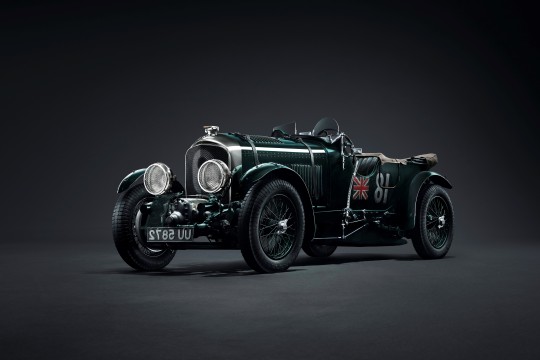
Bentley 4 ½ "Blower"
In 1926, the luxury 6-cylinder 6 1/2 Liter model went on sale, and a year later, the sports Bentley 4 1/2 Liter was designed on its basis by removing two cylinders and reducing the wheelbase. Thus, both vehicles had a solid ladder frame with dependent front and rear suspension on semi-elliptical springs with friction dampers and mechanical drum brakes on all wheels. The all-cast iron 4-cylinder in-line 4-cylinder engine with a displacement of 4398 cm3 featured a very long stroke of aluminum pistons (140 mm with a cylinder bore of 100 mm) and was equipped with a single overhead camshaft driven by bevel gears, which controlled four valves located at an angle of 30 ° through rocker arms and tappets per cylinder. The engine also included two magneto with two spark plugs per cylinder, two SU carburetors, a dry sump and underbody protection.
Design Bentley 4 ½ "Blower"
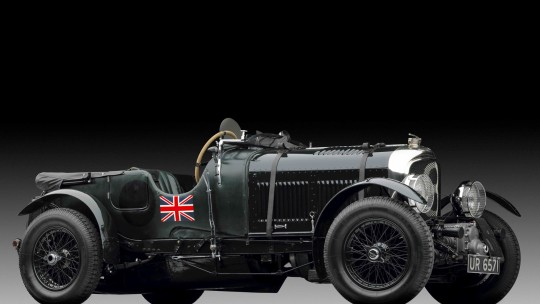
Bentley 4 ½ "Blower"
The atmospheric Bentley 4 1/2 Liter developed 110 hp. in the serial version and 130 hp. in racing, so she was very fast despite weighing almost 1700 kg.
Driving was challenging due to the unsynchronized 4-speed manual transmission and the oversized steering wheel. Easy-to-open fuel and radiator caps and Rudge-Whitworth spoked wheels with a center nut made pit stop service much faster.
The 4-seater open body Le Mans Tourer from Vanden Plas was intended for both racing and city streets. It had three small doors (on the driver's side there was a deep cutout in the sidewall of the body and an external handbrake lever), a folding windshield and a simple fabric awning. The length of the wheelbase was 3300 mm, but on 8 copies it was shortened to 2980 mm.
Design Bentley 4 ½ "Blower"

Bentley 4 ½ "Blower"
Built for the 24 Hours of Le Mans, the Bentley 4 1/2 Liter prototype debuted in 1927 but failed to reach the finish line due to an accident. However, 1928 saw the victory of Wolf Barnato and Bernard Rubin in the atmospheric version; another crew finished 5th.
The following season, the team became the absolute leaders: Jack Dunphy, Dudley Benjafield and Frank Clement in their 4 1/2 Liter took the 2nd, 3rd and 4th places, respectively, after Barnato and Birkin in the Speed Six.
The achievements of the model at Le Mans ended there, but in other races it also showed good results, for example, in 1930 it took 2nd place in 500 miles of Brooklands. From 1927 to 1931 the company produced 720 Bentley 4 1/2 Liter units, including 55 "Blower" compressor units.
Design Bentley 4 ½ "Blower"

Bentley 4 ½ "Blower"
Ironically, the Bentley 4 1/2 Liter "Blower" rose to fame as one of the best race cars of all time without winning a single race.
In addition, Walter Owen Bentley himself has always opposed superchargers, preferring to increase power due to the volume of the cylinders. The idea for the "Blower" came from racing driver Tim Birkin, who suggested installing a compressor on a 4 1/2 Liter Bentley to make it more powerful than the huge Speed Six.
With the financial resources of the millionaire Dorothy Page, Birkin managed to implement the project and convince Bentley to build 55 of these machines for homologation at Le Mans.
Under the hood Bentley 4 ½ "Blower"

Bentley 4 ½ "Blower"
The first "Blower" was created in 1929 by Clive Gallop, Mike Cooper and Amherst Villiers. There was no room for the Roots supercharger under the hood of the production 4 1/2 Liter, so it was installed right in front of the radiator grill.
A compressor with two rotating blades was powered by the crankshaft and pumped the fuel mixture through the carburetors into the intake manifold.
Power increased to 175 hp. in road modification and 242 hp. in racing, but at the same time "Blower" at full speed consumed 4 liters of gasoline per minute.
The engine, supercharger and gas tank were protected with a metal mesh to prevent stones from entering (in 1925 at Le Mans, Frank Clement and John Duff in a Bentley 3 Liter got off the track due to a punctured gas tank).
Interior Bentley 4 ½ "Blower"

Bentley 4 ½ "Blower"
The list of Bentley compressor achievements is very short: 2nd place in the 1929 RAC Tourist Trophy, 2nd place in the 1930 French Grand Prix and the speed record in Brooklands - 222 km / h. In Le Mans, the model performed only in 1930, but both crews did not reach the finish line.
Bentley 4 ½ "Blower"

Thus, the Bentley "Blower" did not secure a single victory for the team, and due to its unreliability brought the company a bad name. Nevertheless, the Blower is the most valuable pre-war racing car today.
Bentley 4 ½ "Blower"

Bentley 4 ½ "Blower"
The Bentley 4 1/2 Liter "Blower" rose to fame as one of the finest race cars of all time without winning a single race.
Specifications
Modification Bentley 4 1/2 Liter "Blower"
Years of issue 1929-1931
Country UK
Manufacturer Bentley Motors Ltd
Produced 55
Category Racing
Body type Two-door phaeton
Bentley 4 ½ "Blower"
I will introduce you to the Cars of the World of different years of release.
Introduce you to the Beauty of the Automotive world.
Bentley 4 ½ "Blower" '1926
Support my channel and subscribe
Vintage Motors Car The Sound Engines
https:www.youtube.com/channel/UC6jpDjNAf_VcTteAYn6MYlg
Who will reblogged, I will block, I warned.
#bentley#blower#bentleyblower#litre#cars#classiccars#race#12#motorsport#lemans#racing#bentleymotorslimitedautomobilecompany#car#1930#bentleyblowersound#vintagebentley#auto#goodwood#bentleyblowerreplicaforsale#blowerbentley#vintage#bentleyblowertowingporsche962#bentleyblowertopgear#bentleyboys#bentleyblowermodel#bentley4½litreautomobilemodel#carmodels#2008#münchen#birkinblowerbentley
0 notes
Text
Alfa Romeo 8C 2300 Le Mans '1931
Alfa Romeo 8C 2300 Le Mans
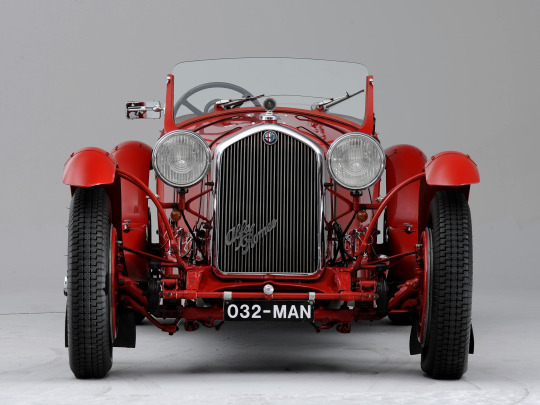
Alfa Romeo 8C 2300 Le Mans
Alfa Romeo is a legendary Italian brand founded in Milan in 1910. Its history reflects the main stages in the development of the entire European car industry. In the early years, she specialized in the production of expensive cars with high dynamic performance. In the 30s. the company reaches the pinnacle of its fame: at the time, Alfa Romeo was considered one of the best sports cars, but only a few could buy them.
Design Alfa Romeo 8C 2300 Le Mans

Another masterpiece by Vittorio Jano and the first model from the 8C series is the Alfa Romeo 8C 2300. By far, at one time it was the most perfect racing car and one of the best cars on the road.
Design Alfa Romeo 8C 2300 Le Mans
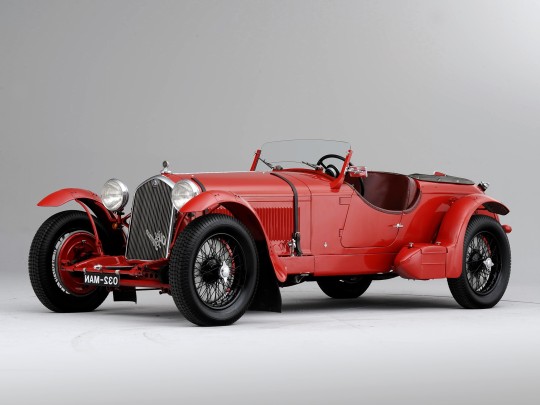
It was developed exclusively for racing, but after the first victories, it was decided to sell the cars to wealthy customers. From 1931 to 1934 the company built 188 chassis of two types: Corto (wheelbase 2750 mm) and Lungo (wheelbase 3100 mm).
Design Alfa Romeo 8C 2300 Le Mans

The 6C 1750 and 8C 2300 engines had the same bore and stroke (65 mm x 88 mm), two camshafts and two valves per cylinder. The 2.3-liter powertrain, however, consisted of two docked all-alloy 4-cylinder blocks and was always equipped with a Roots supercharger. This provided 142 hp, which was transmitted to the rear wheels via a mechanical 4-speed gearbox.
Design Alfa Romeo 8C 2300 Le Mans

Shell's Dynamin fuel, a mixture of gasoline, benzene, ethyl alcohol and castor oil, was fed through a Memini two-barrel carburetor to a compressor mounted on the right side of the engine. The Alfa Romeo 8C 2300 had a U-shaped ladder frame, front and rear suspension on semi-elliptical springs with friction dampers and large diameter drum mechanical brakes on all wheels.
Design Alfa Romeo 8C 2300 Le Mans

The Alfa Romeo 8C 2300 dominated the racetrack for four years with over 50 victories. The first performance at the Mille Miglia due to tire problems ended in an accident for two cars.
Under the hood Alfa Romeo 8C 2300 Le Mans
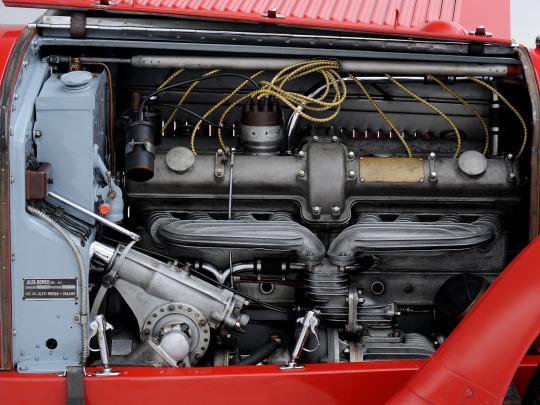
In the next Targa Florio race, the victory went to Nuvolari and his Alfa Romeo 8C 2300, and a couple of weeks later at the Italian Grand Prix in Monza, two crews - Nuvolari / Campari and Minoya / Borzacchini took first and second places.
Interior Alfa Romeo 8C 2300 Le Mans

In 1931, Birkin and Howe won the 24 Hours of Le Mans with this car. The 8C 2300 went on to win Le Mans and Mille Miglia for three years in a row, and also took first and second places in the Monaco Grand Prix in 1932.

The car shown in the photo belonged to Henry Birkin and participated in Le Mans in 1931. The body was built by Touring and had cut-off doors and two additional places covered with an awning. All racing modifications were equipped with a folding windshield and bonnet straps. On the sides of the body, in front of the rear fenders, there were special compartments: the right one for the battery, and the left one for the tools.

I will introduce you to the Cars of the World of different years of release.
Introduce you to the Beauty of the Automotive world.
Alfa Romeo 8C 2300 Le Mans '1931
A Century of Sports Cars
Support my channel and subscribe
Vintage Motors Car The Sound Engines
https:www.youtube.com/channel/UC6jpDjNAf_VcTteAYn6MYlg
Who will reblogged, I will block, I warned.
#8c#alfaromeo#alfa#romeo#monza#alfaromeo8c#2300#1931#alfaromeo8c2300#lemans#museum#car#classic#ferrari#alfa8c#wavelog#blog#le#telewaving#race#bugatti#automotive#simeone#targaflorio#mans#ألفاروميو8سي#model#exhaust#8c2300#nuvolari
0 notes
Text
Lincoln Model KB Dual Windshield Phaeton by Brunn '1932
Lincoln Model KB Dual Windshield Phaeton
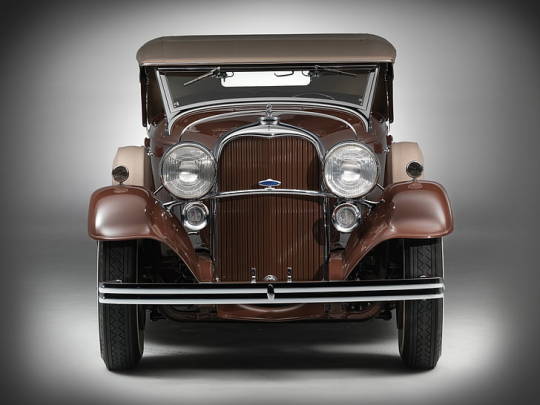
↑ Lincoln Model KB Dual Windshield Phaeton
The car brand, named after the 16th President of the United States, Abraham Lincoln, was created in 1917 by Henry Leland, who left the Cadillac company he founded earlier due to disagreements with shareholders. In 1922, the Lincoln Motor Company was bought by Henry Ford, and since then it has been the luxury division of the Ford Motor Company. From the earliest days under the Lincoln brand, only high-end cars equipped with 8 and 12-cylinder engines were produced.
Design Lincoln Model KB Dual Windshield Phaeton
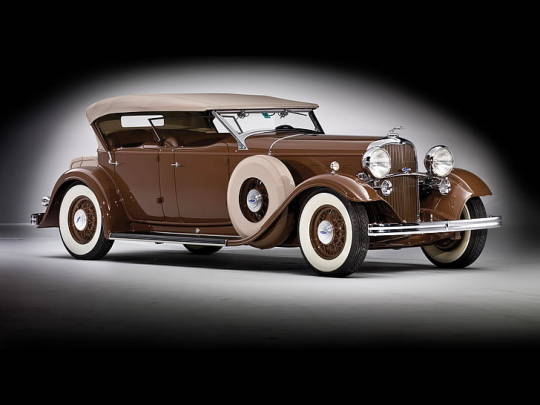
↑ Lincoln Model KB Dual Windshield Phaeton
The lower-valve V8 385 engine of the same displacement (6309 cm3) received a 2-chamber Stromberg carburetor with a downdraft and an increased compression ratio, resulting in an output of 120 hp. The frame is slightly lower and the wheel diameter is reduced from 20 "to 19". A car with a factory body (2 or 4-door phaeton) cost $ 4400, which was equivalent to the price of 10 Ford phaetons. Nevertheless, during the Great Depression, the company even increased its profits by 2%, producing 3311 cars in 1931.
Design Lincoln Model KB Dual Windshield Phaeton

↑ Lincoln Model KB Dual Windshield Phaeton
The car with the old V8 engine, which increased to 125 hp, was now called the Lincoln KA and had a short 136-inch (3454 mm) wheelbase. Both series this year have received a more rounded grille, 18-inch spoke wheels, Bendix Duo-Servo brake booster, side lights on the front fenders and vents on the side of the bonnet instead of grilles.
Design Lincoln Model KB Dual Windshield Phaeton

↑ Lincoln Model KB Dual Windshield Phaeton
Seven body styles were manufactured by Murray and offered for both models. Typically, the Lincoln KA had black fenders and a red badge on the radiator grille, while the Lincoln KB was a two-tone, blue badge.
Design Lincoln Model KB Dual Windshield Phaeton
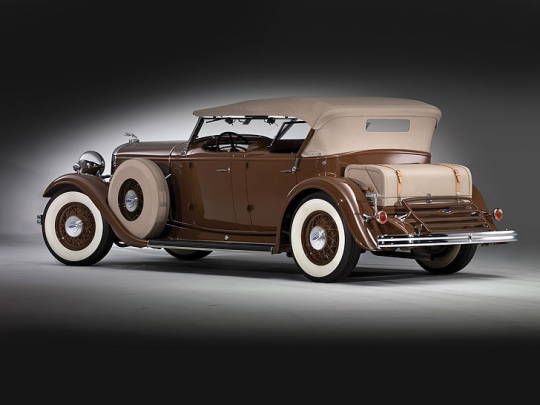
↑ Lincoln Model KB Dual Windshield Phaeton
The 5-seater Lincoln KA sedan cost $ 3200, and the cost of the Lincoln KB has already fluctuated between $ 4300- $ 7200, depending on the bodywork.
Design Lincoln Model KB Dual Windshield Phaeton
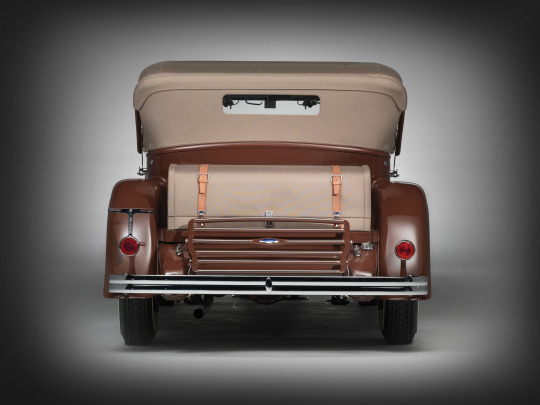
↑ Lincoln Model KB Dual Windshield Phaeton
Body firms offered 24 different styles, with each atelier usually specializing in its own body type: Brunn made convertibles, Willoughby made limousines, Dietrich made coupes and 4-door convertibles, Judkins made sedans and coupes, Murphy made phaetons and roadsters.
Under the hood Lincoln Model KB Dual Windshield Phaeton

Lincoln sales in 1932 amounted to 3406 units, of which 1765 units. KA series and 1641 units. series KB.
Interior Lincoln Model KB Dual Windshield Phaeton

Design Lincoln Model KB Dual Windshield Phaeton
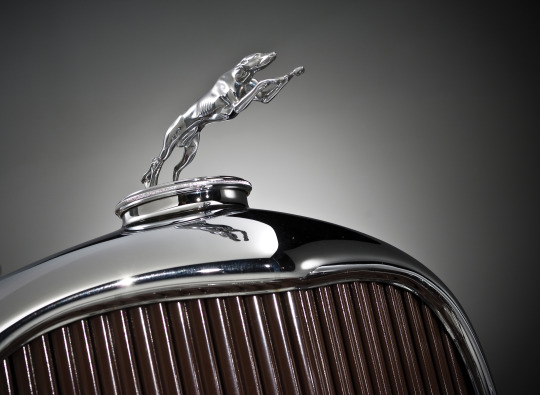
↑ Lincoln Model KB Dual Windshield Phaeton
Body shop: Brunn
In Buffalo, New York, there were two bodybuilding firms called Brunn: Brunn Carriage Mfg. and Brunn & Company. The first, owned by Henry Brun, remained virtually unknown, but the second, founded in 1908 by his nephew Hermann Brun, has become one of the most prestigious American ateliers. Most of its products were produced in 1922-1939. under a contract with Lincoln, but the company also produced single bodies on the chassis
The factory doors closed in 1941.

I will introduce you to the Cars of the World of different years of release.
Introduce you to the Beauty of the Automotive world.
Lincoln Model KB Dual Windshield Phaeton by Brunn '1932
Support my channel and subscribe
Vintage Motors Car The Sound Engines
https:www.youtube.com/channel/UC6jpDjNAf_VcTteAYn6MYlg
Who will reblogged, I will block, I warned.
#lincoln#1932#auto#car#ford#classiccars#kb#sedan#classiccar#classic#antique#lincolnautomobilemake#cars#model#lincolnkb#1932lincolnforsale#vintagecar#auction#autoshowevent#murray#passenger#california#vintage#rare#1933#1931
1 note
·
View note
Text
SEAT Tango Concept '2001
With the two-seater Tango, the SEAT Technical Centre wanted to evoke "the spirit of sporty 50s and 60s convertibles through the use of pure, no compromise, design".
-SEAT Tango-
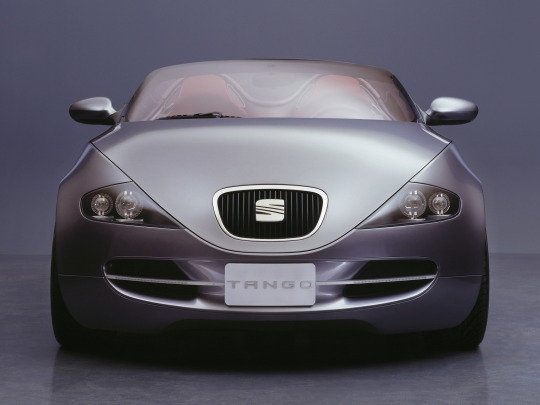
SEAT-Sociedad Ibérica de Automóviles de Turismo
SEAT was founded in May 1950 by the INI, the Instituto Nacional de Industria, a state-owned industrial holding company. In the first half of the twentieth century, Spain had a very limited automobile market, particularly compared to other European countries. There was only limited car production and those that were produced were mainly at the luxury end of the scale.SEAT actually had its origins back in 1940 with the founding of SIAT (‘Sociedad Ibérica de Automóviles de Turismo) by Spanish bank Banco Urquijo.
The aim was to establish Spain’s own mass production car market and was originally going to be a private enterprise but INI took over following a decision by Franco. Because Spain was inexperienced in mass producing their own cars they were going to look for a foreign partner.
However, World War Two was going on and Spain was still recovering from their own Civil War so they delayed the project. And SEAT as we know it was founded in 1950 with 600 million pesetas (almost 3.6 million euros today) and an alliance with Fiat already in the bag. The first car was the SEAT 1400 model, launched in 1953. SEAT was very focused on using as many local Spanish suppliers as possible during the production process, and by 1957 93% of production parts were Spanish.
Design SEAT Tango Concept
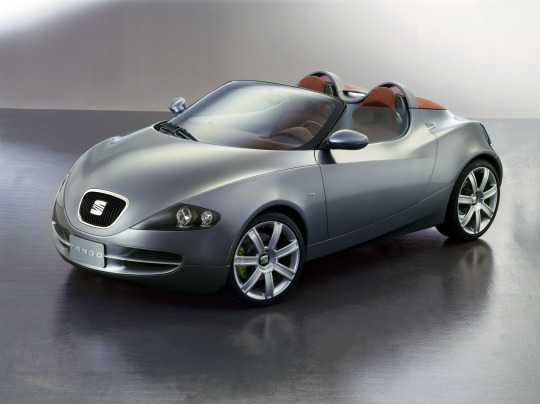
S-E-A-T
The first SEAT launched was actually considered a luxury car, and was therefore highly priced and not affordable to the average Spanish consumer. Because SEAT was lacking in technical expertise, their first models were rebadged or restyled Fiat models and it wasn’t until 1963 that they launched their own self-developed model, the SEAT 800. And it was the SEAT 800 that was the game changer. It was the first car for many Spanish families and was so popular that there is even a monument of the SEAT 800 in Spain.
Design SEAT Tango Concept

S-E-A-T
The main event at SEAT is the show of the Seat Tango roadster, which has very harmonious, balanced forms. "Our job is to create a mood, not an illusion of it," chief designer de Silva said of the show.
Design SEAT Tango Concept
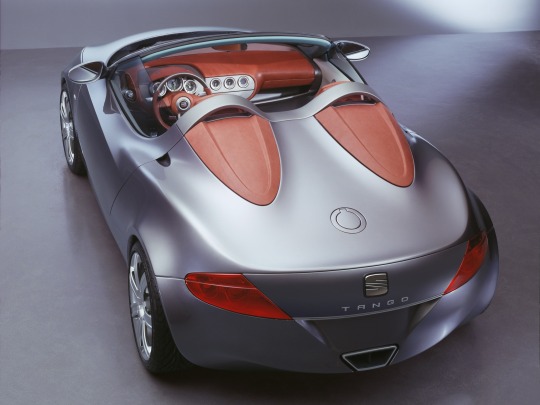
S-E-A-T
Tango is a running prototype, with a 180-horsepower turbocharged 1.8-liter engine, it develops 235 km / h, and reaches “hundreds” in seven seconds. The body of the roadster (3685x1714x1181 mm, base 2200 mm) is aluminum, traditional leather prevails in the interior trim.
Design SEAT Tango Concept

S-E-A-T
There is a kind of roll call of color and texture: the outer and some interior panels are painted with Tango Gray metallic ash, the front panel, seats, steering wheel and “tongues” behind the individual roll bars are matte, rough to the touch, warm chestnut shade. "Tongues", by the way, open, under them there are small trunks. There are racing helmets of the same color!
Design SEAT Tango Concept
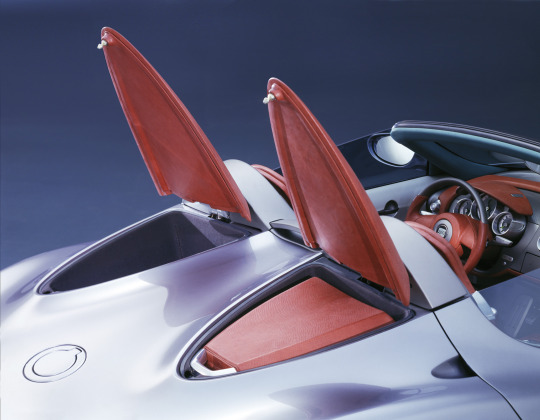
S-E-A-T
Tango bucket seats are motionless (their frames are part of the power circuit of the body) - you will have to adjust the steering column and pedal assembly to fit the figure. A powerful motor with good torque (a peak of 235 Nm is "smeared" in the range from 2100 to 5000 rpm) required a six-speed gearbox.
Design SEAT Tango Concept

S-E-A-T
The front suspension of the car is almost conveyor MacPherson, and the rear, on trailing arms, is endowed with thruster properties. Tango is a car for those who are used to driving pleasure, however, it is equipped with ABS, APS and dynamic stabilization system. The presence of frontal and side airbags does not give out too far plans for SEAT in relation to this car.
Interior SEAT Tango Concept
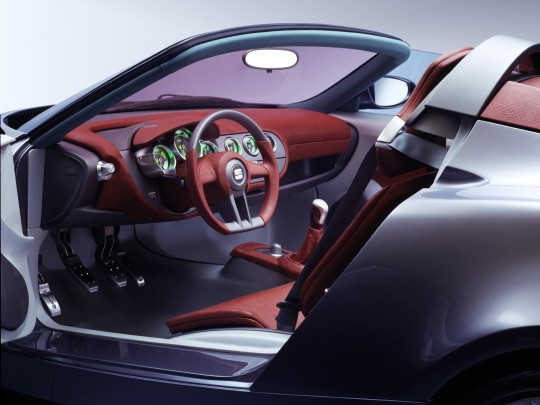
Interior SEAT Tango Concept
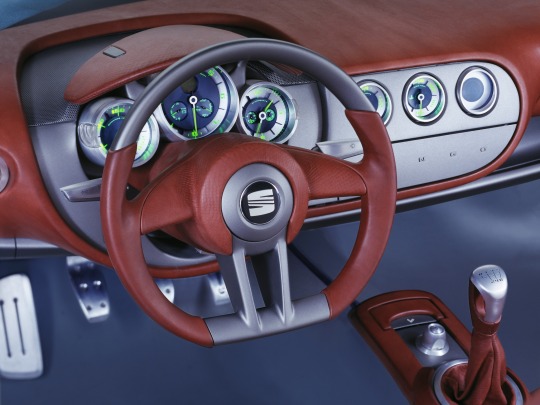
Design SEAT Tango Concept

S-E-A-T
With the two-seater Tango, the SEAT Technical Centre wanted to evoke "the spirit of sporty 50s and 60s convertibles through the use of pure, no compromise, design".
I will introduce you to the Cars of the World of different years of release.
Introduce you to the Beauty of the Automotive world.
SEAT Tango Concept '2001
Support my channel and subscribe
Vintage Motors Car The Sound Engines
https:www.youtube.com/channel/UC6jpDjNAf_VcTteAYn6MYlg
Who will reblogged, I will block, I warned.
#SEAT Tango Concept '2001#SEAT#Tango#concept#2001#cars#design study#Spain#car#spyder#sports#spain#auto#automotive#experimental#experience#automobile
0 notes
Text
Jensen 541R '1957
Jensen 541R '1957
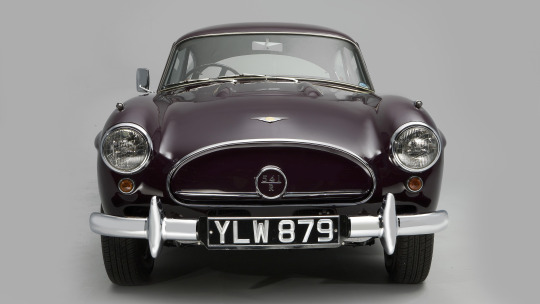
Jensen 541R '1957
Jensen Motors is a company from the English town of West Bromwich, which produced sports cars of the GT class. She started out as a coachbuilder until 1936 she launched her own S-Type with a Ford V8 engine. Subsequently, she supplied bodies for Austin-Healey and fully assembled the Volvo P1800 and Sundeam Tiger sports cars. Jensen's most famous developments are the Interceptor three-door coupe (1966-1976) and its four-wheel drive version FF (1966-1971), which were powered by American Chrysler V8 engines.
Design Jensen 541R '1957

Jensen 541R '1957
Jensen 541 is a four-seater GT car produced by the British company Jensen Motors from 1954 to 1963. It differed from its predecessor, the Jensen Interceptor (1950-1957), in a more stylish, streamlined and lightweight body made of fiberglass panels on a steel tubular frame.
Design Jensen 541R '1957

Jensen 541R '1957
The prototype, unveiled at the London Motor Show in October 1953, had an aluminum body, but for the production version the firm opted for a more modern and practical material, leaving only the doors aluminum. A unique feature of the Jensen 541 was the radiator grille with a temperature-controlled louver that automatically rotated when the engine was hot. The entire front end, including the headlights and fenders, was lifted up for access to the engine compartment from all sides.
Design Jensen 541R '1957

Jensen 541R '1957
The Jensen 541 also features a domed roof with panoramic rear glass and wheel arches like the Mercedes-Benz 300SL. All of these ideas came from designer Eric Neal. The drag coefficient was 0.39.
Design Jensen 541R '1957

Jensen 541R '1957
Most of the technical components for the Jensen 541 were supplied by other companies. The frame was borrowed from the Austin A70, but with a modified front suspension with Panhard rod springs and a leading rear axle with semi-elliptical springs. Under the hood was an in-line 6-cylinder OHV engine from Austin Sheerline with three SU carburetors, a volume of 3993 cm3 and a power of 135 hp. It provided a top speed of 175 km / h.
Design Jensen 541R '1957
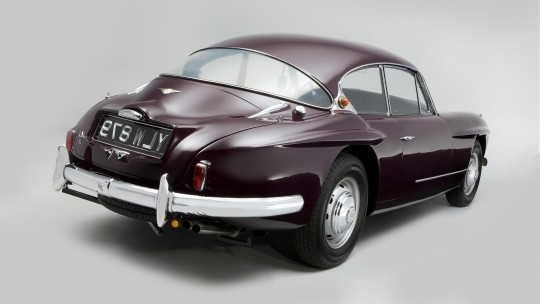
Jensen 541R '1957
The gearbox was a 4-speed manual, for an extra charge - with Laycock de Normanville overdrive. Initially, servo-assisted hydraulic drum brakes were standard, but in 1956 the Jensen 541 Deluxe became the first 4-seater in Britain to be fitted with Dunlop disc brakes at the front and rear. The wheels were offered in two versions: spoked or stamped with a central nut. Inside, the Jensen 541 had a leather interior with separate front seats and a center armrest.
Under the hood Jensen 541R '1957

Jensen 541R '1957
From 1954 to 1958 in West Bromwich, 226 units were built. Jensen 541, two of which were converted by Abbott into Drophead Coupe De Ville convertibles. In 1957, a modification of the Jensen 541R appeared, equipped with a 4-liter 6-cylinder Austin DS7 engine with two carburetors and an increased compression ratio, with a power of 140-150 hp, revised transmission ratios, rack and pinion steering and enlarged disc brakes. 193 units of such cars were sold. They could be distinguished by the chrome moldings on the sidewalls and the visors above the rear wheels.
Interior Jensen 541R '1957

Jensen 541R '1957
In 1960, the Jensen 541S went on sale, which received an extended track, an air intake in the hood and a regular grille in a cage. This was done to improve engine compartment ventilation ahead of the installation of the 5.9-liter Chrysler V8 361 engine with 305 hp. But with the adaptation of the new power unit, problems arose, so it went into production only on the next model Jensen C-V8.
Design Jensen 541R '1957

Most of the Jensen 541S were powered by a 4-liter Austin DS5 inline-6 engine with Weslake head, three SU carburettors and dual exhaust, 150 hp. (one car was powered by a 5.4-liter Chevrolet V8 327 engine at the request of Donald Healy). Standard equipment includes a Rolls-Royce 4-speed Hydramatic automatic transmission (licensed by GM), Salisbury limited-slip differential, seat belts (a first for a British car), fire extinguisher, first aid kit and Motorola radio. 1960 to 1963 127 units were built. Jensen 541S, of which 22 were equipped with a Moss 4-speed manual transmission on customer orders.

I will introduce you to the Cars of the World of different years of release.
Introduce you to the Beauty of the Automotive world.
Jensen 541R '1957
Support my channel and subscribe
Vintage Motors Car The Sound Engines
https:www.youtube.com/channel/UC6jpDjNAf_VcTteAYn6MYlg
Who will reblogged, I will block, I warned.
#jensen#jensen541#541#classiccar#car#jensen541r#541r#classic#oldtimer#classiccars#engine#automobile#interceptor#auto#cars#jenseninterceptor#cv8#jensenff#automobiles#jensencv8#welle#deutsche#dwtv#joc#carinsurance#close#up#homeinsurance#1959jensen541rcoupe#bikeinsurance
1 note
·
View note
Text
#mustang#ford#car#concept#giugiaro#ford mustang#cars#shelby#gt#auto#ford mustang gt#2006#mustang gt#cobra#camaro#show#car review#ford mustang giugiaro concept#los#design#dodge#ford mustang giugiaro#2010#motor#challenger#video#automobile#fabrizio giugiaro#tv#v8
0 notes
Text
Maserati is ready to reawaken the memories that saw it feature in the exciting GT championships, with a hungry new car designed to evoke the exploits of its forerunner, the glorious and victorious MC12.
The Trident's history in motorsport is a story of successes spanning almost a century, of a unique and distinctive DNA, and of a passion being rekindled by the brand's link with the potent legacy from the past and its drive towards the future, in which racing is an essential component.

#maserati#car review#carwow#mat watson#new car review#mc20#gt2#car#car review 2023#ferrari#porsche#new car 2023#racing#supercar#2023#maserati mc20 sound#cars#maserati mc20#racecar#mc20 gt2 top speed#maserati mc20 gt2 sound#v6#exterior#mc20 gt2 sound#styling#interior#maserati corse#porsche 911#maserati gt2#engine
1 note
·
View note
Text
Daimler Double Six 50 Sport Drophead
Coupe by Corsica '1931
Daimler Double Six 50 Sport Drophead Coupe
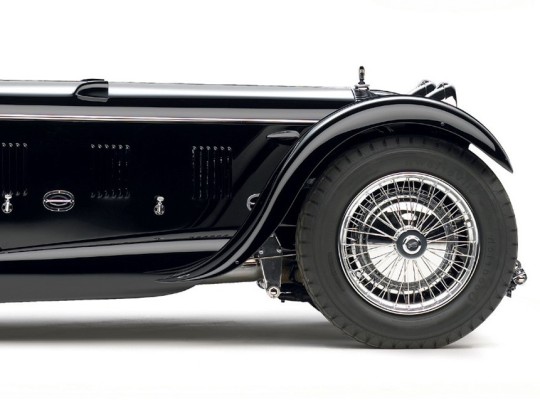
Daimler Double Six 50 Sport Drophead Coupe
The name of the automotive pioneer Gottlieb Daimler was used in their names by three independent companies: German DMG (later Daimler-Benz), Austrian Austro-Daimler and British Daimler Company.
The latter was founded in 1896 in Coventry by Daimler's colleague Frederick Simms, and then entered the Lawson business empire, after the collapse of which it gained independence. From 1910 to 1959 Daimler Company belonged to the Birmingham Small Arms Company (BSA), and since 1960 has been a luxury division of Jaguar Cars, and with it has been part of the British Leyland (1968-1984) and Ford Motor Company (1990-2007).
Design Daimler Double Six 50 Sport Drophead Coupe
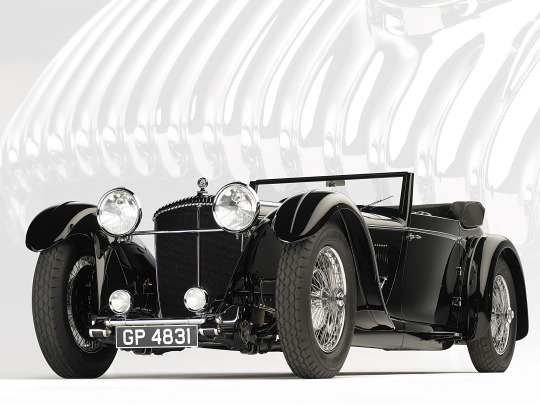
In the first half of the 20th century, there was no more prestigious car manufacturer in Britain than Daimler. At that time, it was often said that Daimler cars were bought only by real Aristocrats.
Design Daimler Double Six 50 Sport Drophead Coupe

As the official supplier of cars for British monarchs in the first half of the 20th century, Daimler was in no way inferior to its main competitor Rolls-Royce. In response to the new Rolls-Royce Phantom introduced in 1925, she developed an even more advanced and stately model, the Daimler Double Six.
Design Daimler Double Six 50 Sport Drophead Coupe

This car was the final of Daimler's Knight series, dating back to 1908. For 20 years, Daimler vehicles have been remarkably quiet in their powertrains, which was unattainable for manufacturers with a traditional poppet valve design.
Design Daimler Double Six 50 Sport Drophead Coupe

In Knight's spool gas distribution system, the valve function was performed by sleeves moving up and down with inlet and outlet holes cut into them, and a camshaft with pushers replaced two chain-driven rods rotating in opposite directions that controlled the spools. The efficiency of such a system was not lower than that of conventional overhead valve engines of that time, and the disadvantages in the form of high oil consumption and a plume of thick smoke left by the car were not yet given much importance.
Design Daimler Double Six 50 Sport Drophead Coupe
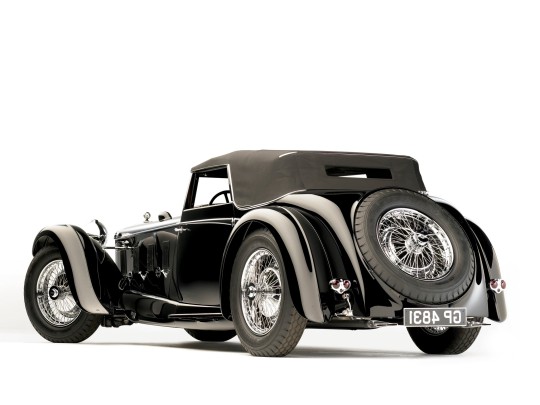
At a time when 6-cylinder engines were still installed on Rolls-Royce, Daimler decided to attract buyers with something more exotic - a V12 engine. Its chief engineer, Lawrence Pomeroy, connected two 25/85 HP inline 6-cylinder blocks at a 60 ° angle with a common aluminum crankcase and a semi-bearing crankshaft, with each block having its own intake and exhaust manifolds, carburetor, water pump and ignition system.
Daimler Double Six 50 Sport Drophead Coupe
He also replaced the cast iron liners with steel liners, reducing oil consumption. The result is a unique 7136 cc V12 engine with 81.5 mm bore and 114 mm stroke, which develops 150 hp. and at idle at 150 rpm did not make a single sound, except for the ticking of spark plugs and a slight whistle of carburetors. The powertrain was mounted on a standard ladder frame with semi-elliptical leaf springs, mechanical drum brakes with a Dewandre vacuum booster and an unsynchronized 4-speed single-plate dry clutch transmission.
Under the hood Daimler Double Six 50 Sport Drophead Coupe
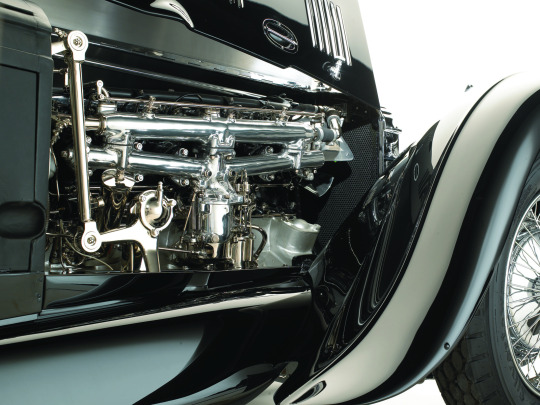
The model, dubbed the Daimler Double Six 50, went on sale in 1926 as a chassis in two wheelbases: 3950 mm (Type O and Type W) and 4140 mm (Type P), priced at £ 1850 or £ 1950. With factory bodies, a sedan or limousine, the finished car cost £ 2,450 or £ 2,800, respectively, but the client could order the body from a third-party atelier.
Interior Daimler Double Six 50 Sport Drophead Coupe

Some later Double Six models had a low, sporty chassis, like the Corsica convertible shown here. The main external difference between the Double Six and the 6-cylinder models was its wide radiator grille, divided into two parts by a vertical chrome line.
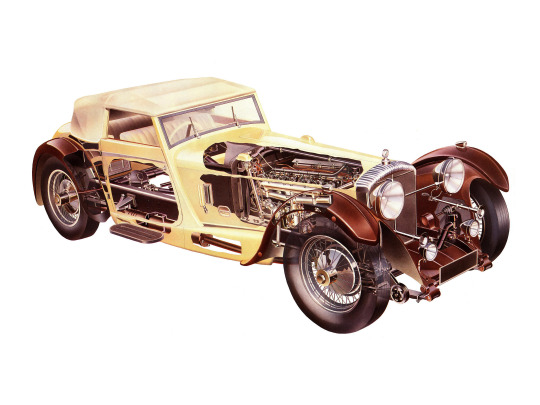
Of the approximately 500 released in 1926-1936. There were only a few 12-cylinder cars for the 7.1-liter Daimler Double Six 50, while the rest were sold in cheaper versions. Since 1927, the Daimler Double Six 30 was available with a 3744 cc (100 hp) engine and wheelbases ranging from 3327 to 3683 mm, costing only £ 1300 for a standard sedan. In 1930, two more versions appeared: Double Six 30/40 (5296 cm3) and Double Six 40/50 (6511 cm3), which had a cylinder block made of light alloy, a fluid coupling with a 4-stage Wilson preselector and hydraulic shock absorbers. In 1934 the company introduced a new line of 8-cylinder Daimler, and the Double Six gradually became a thing of the past.
Daimler Car for Aristocrats

I will introduce you to the Cars of the World of different years of release.
Introduce you to the Beauty of the Automotive world.
Daimler Double Six 50 Sport Drophead Coupe by Corsica '1931
A Century of Sports Cars
Support my channel and subscribe
Vintage Motors Car The Sound Engines
https:www.youtube.com/channel/UC6jpDjNAf_VcTteAYn6MYlg
Who will reblogged, I will block, I warned.
#Daimler Double Six 50 Daimler#classiccars#rollsroyce#mostexpensivecars#daimler#rarecars#car#cars#lanciaaurelia#ferrari250gtswb#astonmartindb4gtzagato#wikipediaaudioarticle#mercedesbenz300sl#automotivetransmissionmakers#britishbrands#maseratia6gcs#daimlercompany#concoursofelegance#carspoweredbyknightengines#ferrari166mmbarchetta#accobra289#ferrari250gto#fordgt40mkiii#lamborghinimiurasv#jaguaretype#bmw507#learningbylistening#alfaromeo8c#maseratibirdcage#jaguarxkss
0 notes
Text
Ferrari FZ93 '1993
Ferrari FZ93

#supercar#car#cars#ferrari#coupe#gt#exotic#factory#spider#new#topgear#lap#topmarques#time#challenge#flames#crazy#drag#drift#motorshow#vs#launch#rev#v12#sound#crash#v8#hypercars#supercars#hypercar
1 note
·
View note
Text

#bertone#car#auto#automobile#vehicle#cars#motor vehicle#motor car#bertone birusa#ferrari#porsche#tuning#custom#concept#bmw#севера#дороги#design#chevrolet#alfa romeo#concept cars#lamborghini#concept car#supercar#z8#обзор авто#самоделки#топ 10#вездеходы#4x4
1 note
·
View note
Text

#mclaren720sgt3x#mclaren#mclaren720s#720sgt3x#720s#gt3x#mclaren720sgt3#mclaren720sacceleration#racing#gt3#mclaren720ssound#car#mclaren720sgt3sound#mclaren720sgt3xprice#f1#mclaren720sreview#racer#2021mclaren720sgt3x#mclaren720sexhaust#gt3xmclaren#cars#mclaren720svszl1#mclaren765lt#newmclaren#supercar#mclaren720scinematic#mclaren720sinterior#xemclaren720s#mclaren720sflames#mclaren720sspider
1 note
·
View note
Text




Aston Martin DB2/4 Spider (Bertone) ' 1954
In 1954, the American industrialist, Stanley Harold "Wacky" Arnolt commissioned the Italian coachbuilder, Bertone, to produce a stunning Spider based on the Aston Martin DB2/4 chassis.In total, eight rolling chassis were supplied to Bertone, Two became drophead coupes, one or two were fixed-head coupes and four (or five) were spiders.This particular car, chassis number 505 was the work of Franco Scaglione. For eight years, Scaglione was chief designer at Bertone and was responsible for both the "Arnolt" MG and Bristols, plus the Alfa Guilietta Sprint and 1954 BAT 5 Show Car.

#astonmartin#car#db2#martin#classic#aston#cars#classiccar#tuning#automobile#db24#bertone#auto#racing#drive#automotive#supercars#custom#vehicle#design#авто#alfaromeo#astonmartindb24automobilemodel#mercedes#oldtimer#astonmartindb24#vantage#astonmartindb2#porsche#gt
2 notes
·
View notes
Text
BMW 2002 Hommage Concept '2016
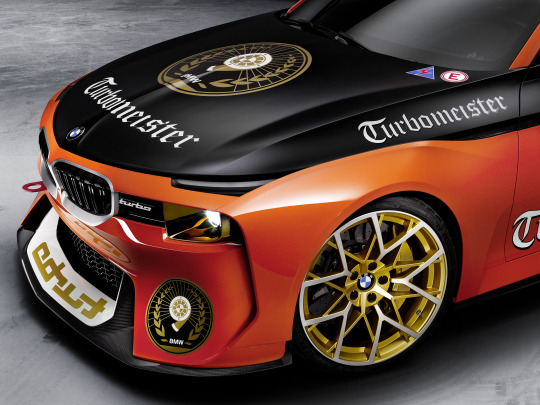
BMW 2002 Hommage
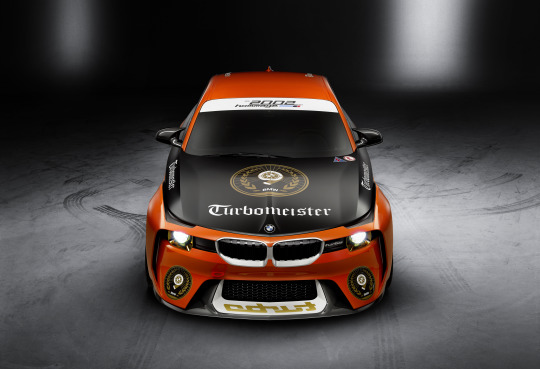
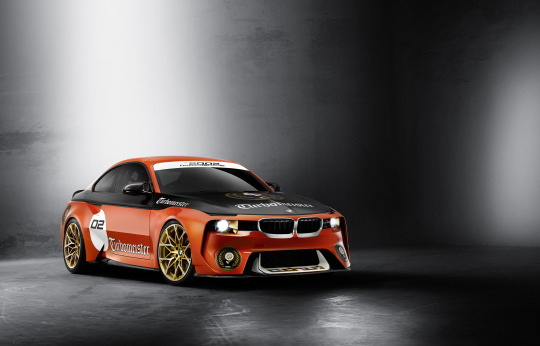
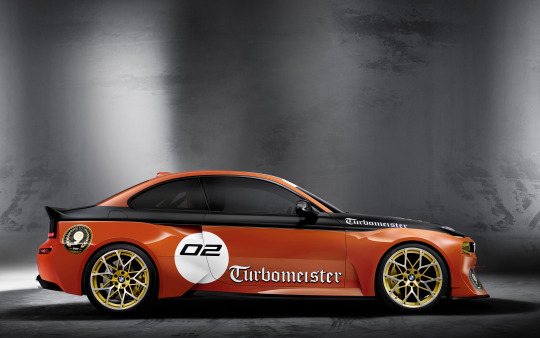


BMW 2002 Hommage

The debut of the concept car is dedicated to the 50th anniversary of the BMW 02 series, which later became one of the most famous models in the history of the brand. The BMW 2002 Hommage Coupé is based on the current BMW M2 model, but the body of the car has been thoroughly redesigned: the concept has embossed sidewalls with wide wheel arches, an original front design inspired by the classic model and characteristic direction indicators above the headlights.
The BMW 02 series, which was the predecessor of the third series, debuted in 1966 - it was a two-door BMW 1602 with a 1.6-liter engine. Later, a two-liter version of the BMW 2002 appeared in the range, variants with cabriolet and hatchback bodies, the brand's first turbocharged car BMW 2002 turbo and other modifications. Zero second cars were a massive success and laid the foundation for the brand's driver reputation.

I will introduce you to the Cars of the World of different years of release.

#bmw#bmw 2002 hommage#hommage#concept#car#2002#cars#bmw 2002#turbo#2016#villa d'este#concept car#bmw 2002 turbo#review#2002 hommage#new#drive#engine#automotive#sound#test#auto#bmw m2#turbomeister#pebble beach#2016 bmw 2002 hommage concept#bmw concept#exhaust#avto#driving
1 note
·
View note
Text

WALD Bentley Continental GT Sports Line '2008


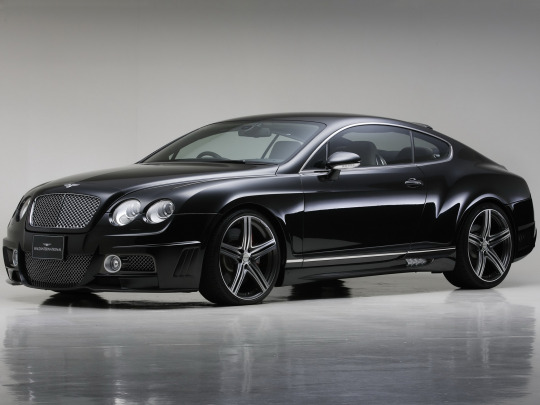


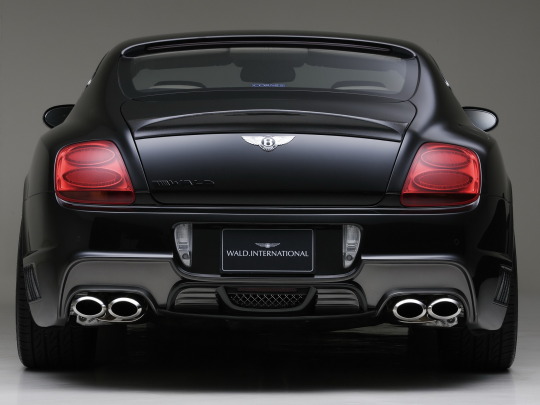

I will introduce you to the Cars of the World of different years of release.
Who will reblogged, I will block, I warned.
#bentley#continental#wald#gt#nissan#2008#bmw#black#cars#audi#mercedes#bison#lamborghini#tuning#flying#spur#gtr#концепт#тюнинг#тачки#turbo#maserati#power#авто#brabus#dealership#racing#vidbrid#porsche#toyota
1 note
·
View note
Text
#aston martin#aston martin dbs 770 ultimate#aston martin dbs#dbs 770 ultimate#aston martin dbs 770#dbs#aston martin 2023#aston martin v12#aston martin dbs superleggera#aston martin 770#dbs 770#aston dbs#aston martin vantage#dbs superleggera#v12#aston#new dbs#aston martin superleggera#aston martin dbs 770 ultimate teased for the first time#martin#aston martin sound#aston martin amr#james bond#test drive#supercar#2023 aston martin#aston dbs 770 ultimate#2023 aston martin dbs 770 ultimate#aston martin dbs 770 ultimate coupe#aston martin dbx
0 notes
Text
Chevrolet Corvette Moray '2003
Chevrolet Corvette Moray

Corvette Moray
Chevrolet is the largest and first-ranked division of the General Motors Group (GM). It was formed in 1911 as an independent Chevrolet Motor Car Company, co-founded by industrial tycoon William Durant and race car driver Louis Chevrolet. By creating a new venture, Durant set himself the goal of regaining control of the GM corporation. When he succeeded, in 1918 Chevrolet became part of GM. Initially, relatively expensive cars were produced under the Chevrolet brand, but in the 1920s. GM President Alfred Sloan put Chevrolet at the bottom of its price hierarchy and consolidated its budget brand image from the "low-cost three" (Ford, Chevrolet and Plymouth). However, at the end of the 20s. The Chevrolet was powered by a Stovebolt 6-cylinder engine, much more powerful than Ford's 4-cylinder engine. As a result, Chevrolet was able to surpass Ford in sales and take the leading position in the American market.
Design Chevrolet Corvette Moray
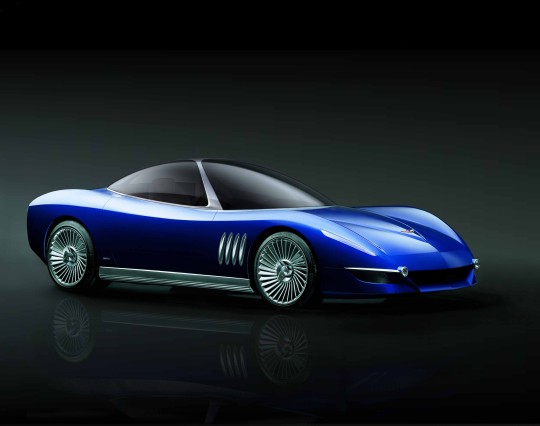
Chevrolet Corvette Moray Concept by Italdesign
On March 4, 2003 at the Geneva Motor Show was presented the Moray project like a homage that Giorgetto and Fabrizio Giugiaro wish to pay to the fifty-year era of the Chevrolet Corvette, the supreme symbol of the American sports car.
Design Chevrolet Corvette Moray
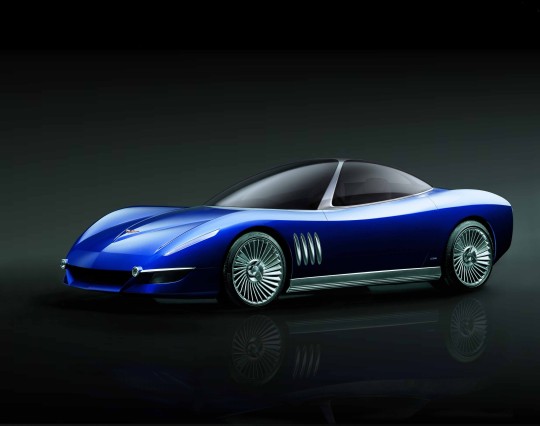
Corvette Moray
The new car design has an elegant extreme leaps into the limelight carrying a pure profile, designed as though touched by drifting tides with long and slender front lights, more accentuated curvature is the serpentine bonnet (which projects frontward) forming a contrast with the upraised cut-off tail.
Design Chevrolet Corvette Moray
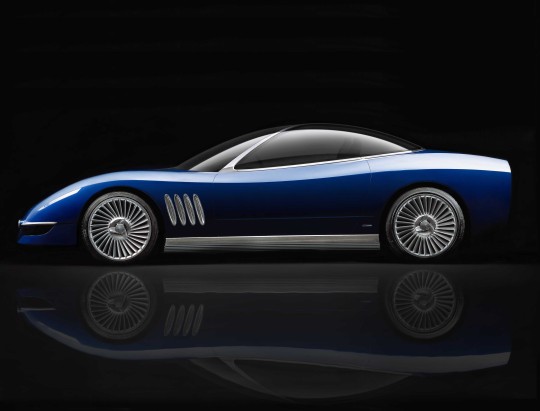
Corvette Moray
In order to assure freedom of access to the inside of the car the clear crystal semi-dome of the doors, by which the side window and roof merge into one complete unit, swings open like a seagull on wing which you can remove these door wings quick and simple to transform the Moray from a coup, with its unmistakable roof panel under the unique, clear crystal dome, into a quasi roadster. For an immediate feeling of fresh-air motoring you can replaced the B door by a central arch-shaped steel structure to which the two wings are hinged.
Design Chevrolet Corvette Moray

Corvette Moray
The side-mirrors have been replaced by a telecamera system with dashboard-integrated viewers. Inside the car only those surfaces car touched by the driver or passenger are warmed by soft leather upholstery made with the cooperation of Drxlmaier Group. The bodyshell and paintwork color blends into the capsule, becoming one and the same.
Design Chevrolet Corvette Moray

Corvette Moray
Essential to catering the needs and preferences of the dynamic driver are dashboardfitted instruments. Underlined by the same dashboard layout, assigned to the passenger are precise co-pilot functions. The Moray is fitted with a powerful Chevrolet Corvette V8 engine, the longitude front-mounted six-liter, which reaches command of more than 400 horsepower, combined with a perfect balance ensured from the ground up by Michelin Pilot sport 335/30 ZR20 rear tyres.
Design Chevrolet Corvette Moray

Corvette Moray
According to the authors, this is “the dream of Italian dreamers, inspired by the American dream,” and dreams, alas, are not replicated.
Design Chevrolet Corvette Moray
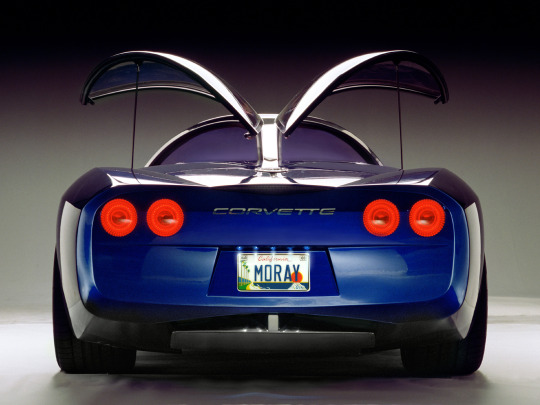
Interior Chevrolet Corvette Moray
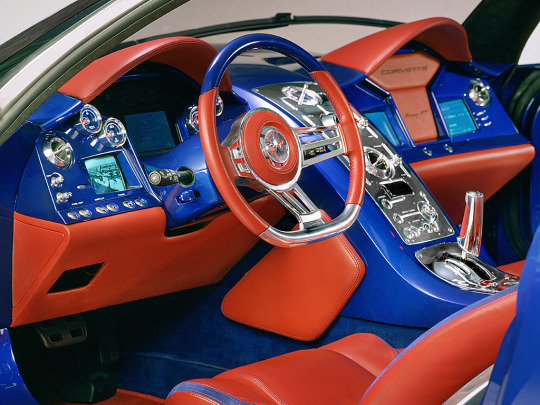
Corvette Moray
Chevrolet Corvette Moray is a project by ItalDesign, dedicated to the 50th anniversary of the American sports car. Unveiled at the 2003 Geneva Motor Show, this car combines the signature features of the last three generations of Corvette with the tradition of Italian bodywork.
Specifications
Chevrolet Corvette Moray modification
Years of issue 2003
Country: USA
Manufacturer General Motors Corporation
Produced 1
Category Concepts
Design by ItalDesign
Body type Two-seater coupe

I will introduce you to the Cars of the World of different years of release.
Introduce you to the Beauty of the Automotive world.
Chevrolet Corvette Moray '2003
Support my channel and subscribe
Vintage Motors Car The Sound Engines
https:www.youtube.com/channel/UC6jpDjNAf_VcTteAYn6MYlg
Who will reblogged, I will block, I warned.
#cars#car#corvette#chevrolet#auto#chevy#vehicle#price#automobile#specs#releasedate#2015#classiccars#sportbike#motorcycle#2016#2017#motorcar#motorvehicle#spied#spyshot#bike#musclecars#specification#conceptcars#motorshow#autoshow#sportcars#image#vehicles
1 note
·
View note
Text
Rolls-Royce Cullinan “Billionaire” by Mansory (2020)
Mansory’s Rolls-Royce Cullinan “Billionaire” Actually Costs Less Than A Million.The tuned Rolls Royce Cullinan gains an extra 39HP and crocodile leather inside.
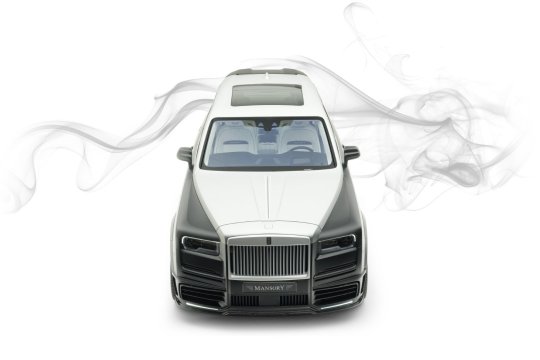




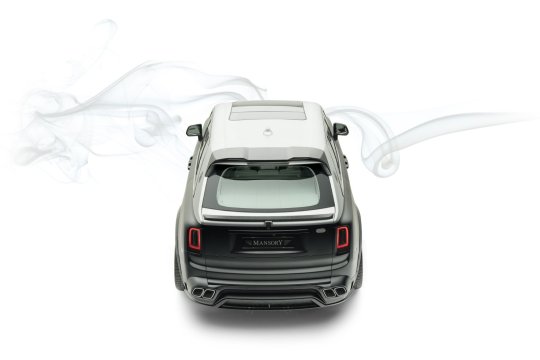

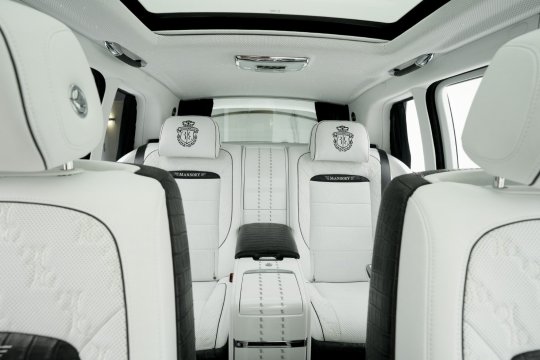

Rolls-Royce Cullinan “Billionaire”
Atelier Mansory presented at the Geneva Motor Show a project based on the Rolls-Royce Cullinan SUV, which was called Billionaire (“billionaire”). In total, the tuner will build 13 such machines, and the cost of each of them will be at least 785 thousand euros.
The car got its name in honor of the German luxury clothing brand Billionaire, with which the car was developed.The brand logo is placed on the headrests, seat upholstery and door panels.The armrests and sides of the seats are upholstered in crocodile leather, and white leather is used to decorate other parts of the interior.
For the SUV, the tuner has prepared an aggressive body kit with enlarged air intakes in new bumpers, a carbon fiber spoiler, a massive diffuser, extended wheel arches and sills.The car also received four large rectangular exhaust pipes and 24-inch wheels with 295/30 tires.
The power of the 6.75-liter V12 engine has increased by 40 horsepower and maximum torque by 100 Nm. Now the unit produces 611 forces and 950 Nm. "Hundred" the car is gaining in less than five seconds.The maximum speed is 280 kilometers per hour.

I will introduce you to the Cars of the World of different years of release.
Rolls-Royce Cullinan “Billionaire”
Who will reblogged, I will block, I warned.
#rolls royce cullinan#cullinan#mansory#rolls royce#rolls royce cullinan mansory#cullinan mansory#cullinan billionaire#rolls royce mansory#billionaire#rolls royce cullinan 2021#rolls royce 2022#mansory cullinan#luxury#mansory rolls royce cullinan#2021 rolls royce cullinan#rolls royce 2021#cullinan 2021#rollsroyce#2020 rolls royce cullinan#mansory 2021#rolls royce billionaire#2022 rolls royce cullinan#rollsroycecullinan#cars#rolls-royce cullinan billionaire#rolls-royce cullinan#rolls-royce#best luxury suv 2021#best luxury suv 2020#mansory 2020
1 note
·
View note